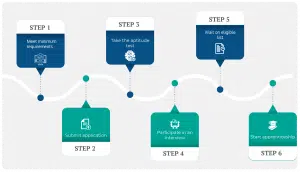iPREP is a trusted test‑prep provider offering a full Postsecondary Education Readiness Test (PERT) prep course, and on this page you can access free sample questions with full explanations and video walkthroughs.
You’ll get:
- Free real‑style PERT questions
- Instant right/wrong feedback
- Step‑by‑step written solutions
- Short video explanations for every answer
Test Breakdown with Sample Questions
The PERT test is used by Florida higher educational institutions to determine a student’s correct academic level in math and English. It is divided into three sections, which assess the student’s ability in the following partial list. Please see the FAQ section for a more complete list:
- Math – Solve equations, Evaluate algebraic expressions, Work with polynomials
- Reading – Analyze written pieces of text, Recognize relationships within and between sentences
- Writing – Establish a topic or thesis, Demonstrate proper use of grammar
The test is untimed and taken on a computer.
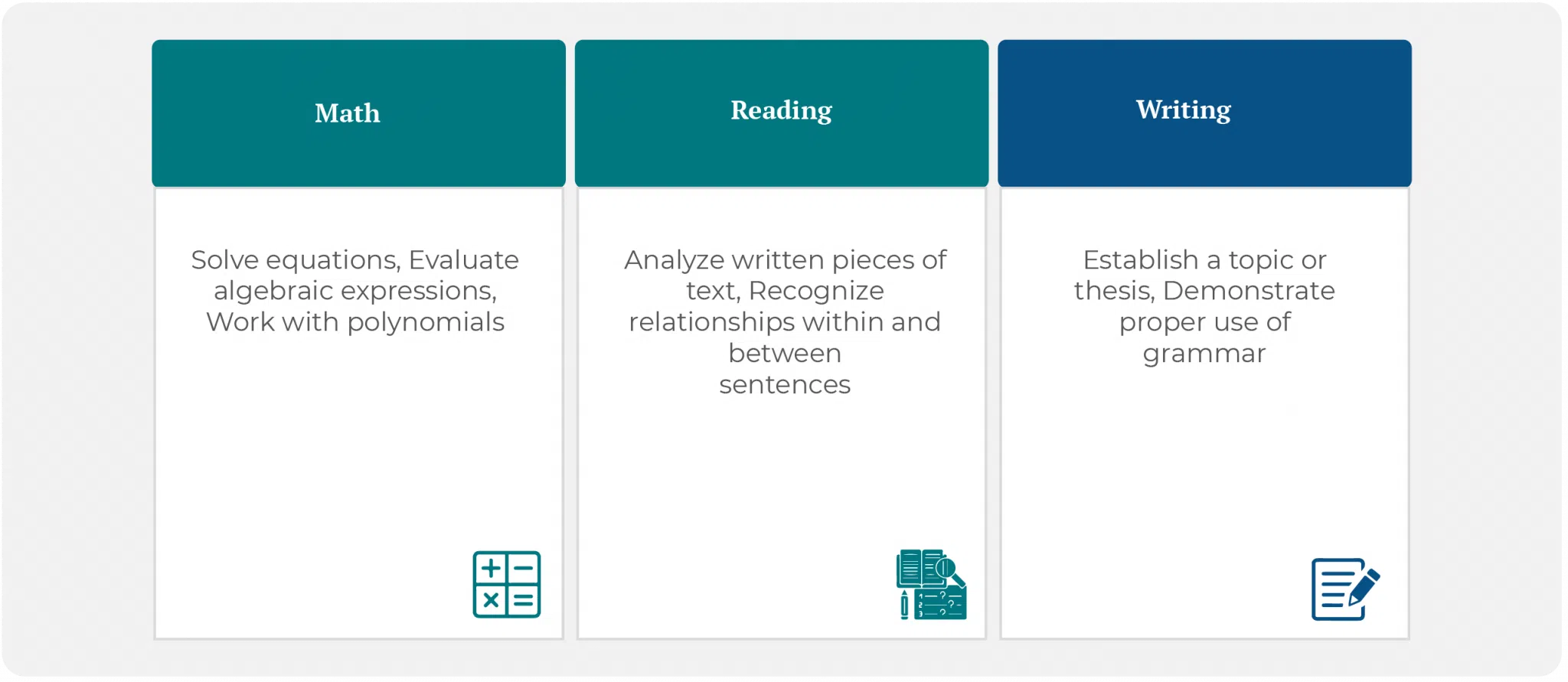
Each test is different, as the questions are computer-adaptive. Questions are based on a student’s previous correct and incorrect responses.
Calculators are not allowed to be brought into the test, although some questions contain a pop-up on-screen calculator.
Did you know?
The PERT Test has 3 sections: (1) math, (2) reading, and (3) writing. There is no pass/fail score for this test, although students need a 103-114 in the different sections to be eligible for standard college-level classes. Students with an 11th grade level of math and English should do well on this test.
Technical Facts
There is a total of 90 questions on the PERT test. The questions are all multiple-choice, with each question offering the test taker 4 potential answers.
Each of the three sections ( math, reading, writing) contains 25 graded questions and 5 non-graded questions that are field test questions and unscored. Test takers do not know which questions are scored and which are field test questions.
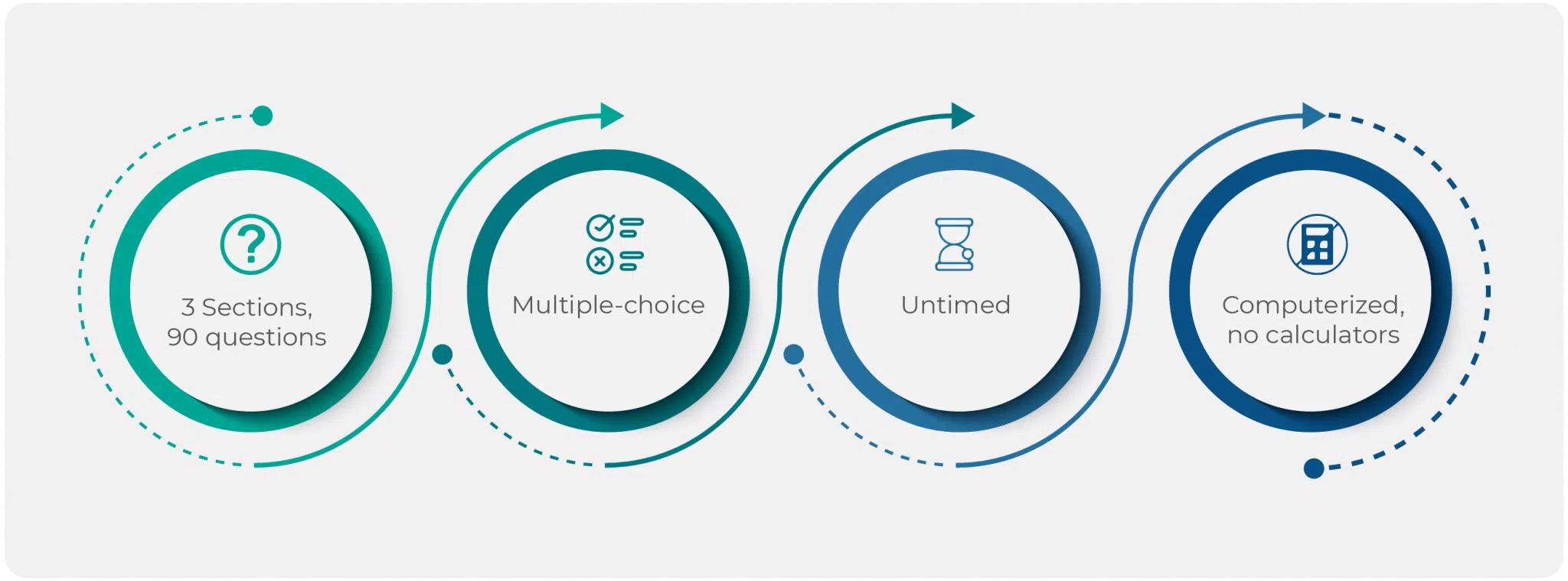
PERT tests are free for first-time test takers. Additional attempts may have a fee assessed, depending on the institution giving the test. PERT scores are valid for 2 years.
Most Florida high school students take the PERT in 11th grade, although students with high SAT or ACT scores may not be required to take the test. College-ages students who wish to attend a Florida college typically take the test at the school they intend to attend.
Results Scale and Interpretations
Test takers can score between 50-150 points in each section. While there is no pass or fail to the test, an individual’s score is used to determine their course level for math and English classes.
PERT Standard Scores
The Florida State Board of Education lists the following as their standard scores for each section:
| Standard Scores Approved by the State Board of Education |
|---|
| Postsecondary Education Readiness Test |
| (a) PERT Reading | 106 |
| (b) PERT Writing | 103 |
| (c) PERT Mathematics | 114 |
PERT Scores Vs. Equivalent Tests
The following table shows the equivalent scores in other tests:
| Section | PERT | Accuplacer Classic | SAT | ACT |
|---|---|---|---|---|
| Reading | 106 | 83 | 24 | 19 |
| Writing | 103 | 83 | 25 | 17 |
| Math | 114 | 72 | 24 | 19 |
How PERT Affects College Placement
Different schools have somewhat different classroom opportunities for their students, and some may view scores somewhat differently. The following two examples underline the developmental classes you may be required to take, based on your score.
Example 1
| Score | Class |
|---|---|
| Reading | |
| 50-83 | Developmental Reading and Writing I |
| 84-105 | Developmental Reading and Writing II |
| 96-105 | Developmental Reading Module |
| 106-150 | Freshman Composition I |
| Writing | |
| 50-89 | Developmental Reading and Writing I |
| 90-102 | Developmental Reading and Writing II |
| 103-150 | Freshman Composition I |
| Math | |
| 50-95 | Developmental Math I |
| 96-113 | Developmental Math II |
| 96-150 | College Math |
| 114-122 | Intermediate Algebra |
| 123-150 | College Algebra |
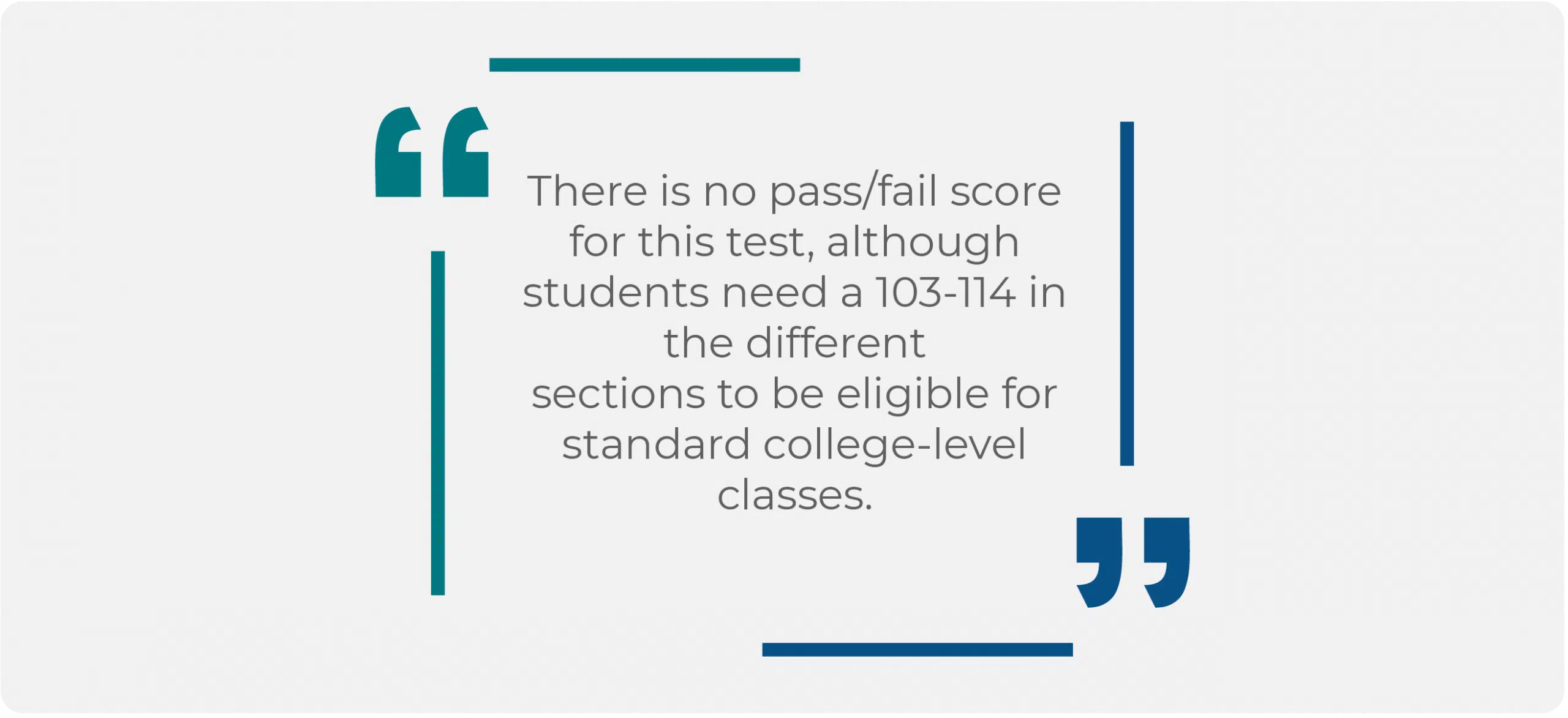
Example 2
| English Placement Levels |
|---|
| TEST | ENC0017- Integrated Reading and Writing I | ENC0027- Integrated Reading and Writing II | ENC 1101L- English Composition I Lab* | LIN 1670- Writing and Grammar | ENC 1101- English Composition I* |
| PERT | 50-89 | 90-102 | 100-116 | 103-116 Strongly Recommended | 103-150 & Reading 106-150 |
| Reading Placement Levels |
|---|
| TEST | ENC0017- Integrated Reading and Writing I | ENC0027- Integrated Reading and Writing II | REA 0056- Developmental Reading Module | ENC 1101- English Composition I |
| PERT | 50-83 | 84-105 | 96-105 | 106-150 & Reading 103-150 |
| Math Placement Levels |
|---|
| COURSE | MAT 0018 Developmental Math I | MAT 0028 Developmental Math II MAT 0157 Mod. Dev. Math II | MAT 0056 Dev. Math Module | MAT 1033A Intermediate Algebra | MAC 1105 College Algebra STA 2023 Statistics |
| PERT | 50-95 | 96-113 | 105-113 | 114-122 | 123-150 |
iPREP: Concise. Focused. What you need.
Sign up
Immediate access
Practice
Online self-paced
Pass
Ace that Test!
PERT FAQs
There is no time limit for the PERT test. Students should allow for three hours, giving them an average of one hour per section, although some students will find that they don’t need that much time.
Bring a valid form of identification, such as a driver’s license or passport. You will not be allowed to bring any electronic devices or a calculator into the test.
The best way to prepare is to take practice tests, like the one offered by iPrep. While taking the test, read each question carefully, to be sure that you know what the question is asking. Take your time, since there is no time limit, and use reasoning when answering.
For example, make sure to identify the key phrase in the question, and try to find the correct answer before looking at the choices offered by the test. If you are not certain of the answer, eliminate the choices that are definitely incorrect.
Finally, read through the remaining options and pick the best answer. If you are unsure of an answer, you should guess.
Before clicking next and moving on to the next question, review your answer. There is no way to go back to a previous question once you’ve submitted your answer.
To do well on the 30 questions in the PERT Math section, you’ll want to make sure you can do the following:
– Know how to solve linear equations, linear inequalities, quadratic equations and literal equations
– Understand how to evaluate algebraic expressions
– Be able to factor, simplify, add, subtract, multiply and divide polynomials
– Know how to divide by monomials and binomials
– Have a strong understanding in how to apply standard algorithms or concepts
– Know how to coordinate planes, so you can translate between lines and inspect equations
– Understand how to focus on pairs of simultaneous linear equations in two variables
The 30 PERT questions in the reading section will test you in the following areas:
– Ability to discern and summarize the most important ideas, events, or information
– Ask you to support or challenge assertions about the text
– Test your ability to determine the meaning of words and phrases in context
– Ability to analyze the meaning, word choices, tone and organizational structure of the text
– Capacity to determine the author’s purpose and the relation of events in the text to one another
– Proficiency in recognizing relationships within and between sentences
– Skill in analyzing traits, motivations and thoughts of individuals in fiction and nonfiction
– Expertise in analyzing how two or more texts with different styles, points of view or arguments address similar topics or themes
– Aptitude for distinguishing between facts and opinions
– Ability to evaluate reasoning and rhetoric of an argument or explanation
Remember to take your time while reading through the passage. Focus on opening and ending sentences in each paragraph, to help identify the main idea.
The PERT writing section of the test challenges test takers over the course of 30 questions in their ability to do the following:
– Ability to sustain focus on a specific topic or argument
– Establish a topic or thesis
– Demonstrate use of the conventions of standard written English, including grammar, usage and mechanics
– Support and illustrate arguments and explanations
– Develop and maintain a style and tone
– Synthesize information from multiple relevant sources
– Convey complex information clearly and coherently
– Represent and accurately cite data, conclusions, and opinions of others
– Establish a substantive claim and acknowledging competing arguments or information
– Ability to recognize effective transitional devices within the context of a passage
– Recognize commonly confused or misused words and phrases
– Use modifiers correctly; using coordination and subordination effectively; and recognizing parallel structure
– Recognize correct grammar, spelling, capitalization, and punctuation
PERT stands for the Postsecondary Education Readiness Test. It is a standardized test, similar to the ACT and SAT, which helps Florida colleges and universities place incoming students into math and English classes that are appropriate for their skill set.
PERT tests aren’t graded on a pass/fail basis. However, for students looking to take college-level English and math classes, rather than developmental courses, they will want to score a 106 or higher in reading, a 103 or higher in writing, and a 114 or higher in math.
Retakes are available, although there isn’t a consistent policy across the state of Florida for this test.
For high school students, each school district determines a student’s ability to retake the test.
For college-age students, each school has a different policy. While there are some schools that allow for a retake after 24 hours, most require a 30-day waiting period, and many require proof that the student has taken a remediation course before they allow a second test.
For your convenience, here are two school policies:
1. Miami Dade College
“MDC students have a total of two placement test attempts (one initial attempt and one retest) on each subtest of the placement test for initial placement prior to enrollment in any course within that subject area. Prior to the 2nd attempt, students must complete a test preparation option. After the 2nd attempt, students must complete a prescribed remediation option and receive permission to retest from the Developmental Education and/or Mathematics Chairperson. Successful completion of Boot Camp (Shark Academy) courses REA 0014 – Reading, EDU 0016 – Mathematics, or EDU 0017 – Writing may be used in lieu of receiving chairperson permission.”
2. Broward College
“Students may retake the PERT an unlimited number of times. However, they must adhere to the following retesting timeline:
– First retest attempt may be taken after 24 hours.
– All other retest attempts must wait 30 days between each retest attempt.
Remediation prior to each test attempt is strongly encouraged.
The state of Florida covers the cost for high school students, and most colleges don’t charge their students to take the test for the first time.
However, students who wish to take the test a second time to improve their scores do have to pay a fee. Each college sets its own fee policy, which seems to range from $10-$20.
For your convenience, here are two school policies:
1. Miami Dade College
First Test – No Fee
Second Attempt – $10
2. Broward College
First Test – No Fee
All Subsequent Attempts – $18.50
PERT Test Tips
To do well on a test that covers reading, writing, and math, you need to have precision, plan, and practice. Although it may be difficult, the following tips will help:
1. Take your time and do not rush through the questions
The PERT is non-timed so you have all the time to make sure that you completely understand the question and positive about how you have answered it.
2. Know your weaknesses and strengths
While practicing, you will come across topics that you might find tricky aside from topics that are easy; identify them and work on them. Leave the topics you are most fearful of and practice the ones you enjoy.
3. Keep calm
Being stress-free doesn’t mean you start cracking lame jokes of course. Just stay calm and focus on the test; you prepared for the test and you should be ready.
4. Skip and move on if needed
Sometimes a question might be just too difficult or confusing. Answering these questions might crack your concentration and impair your performance in the rest of the test. It is ok to give up on one or two questions with no remorse in order to ace the rest of them. Simply forget about it and skip to the next question.
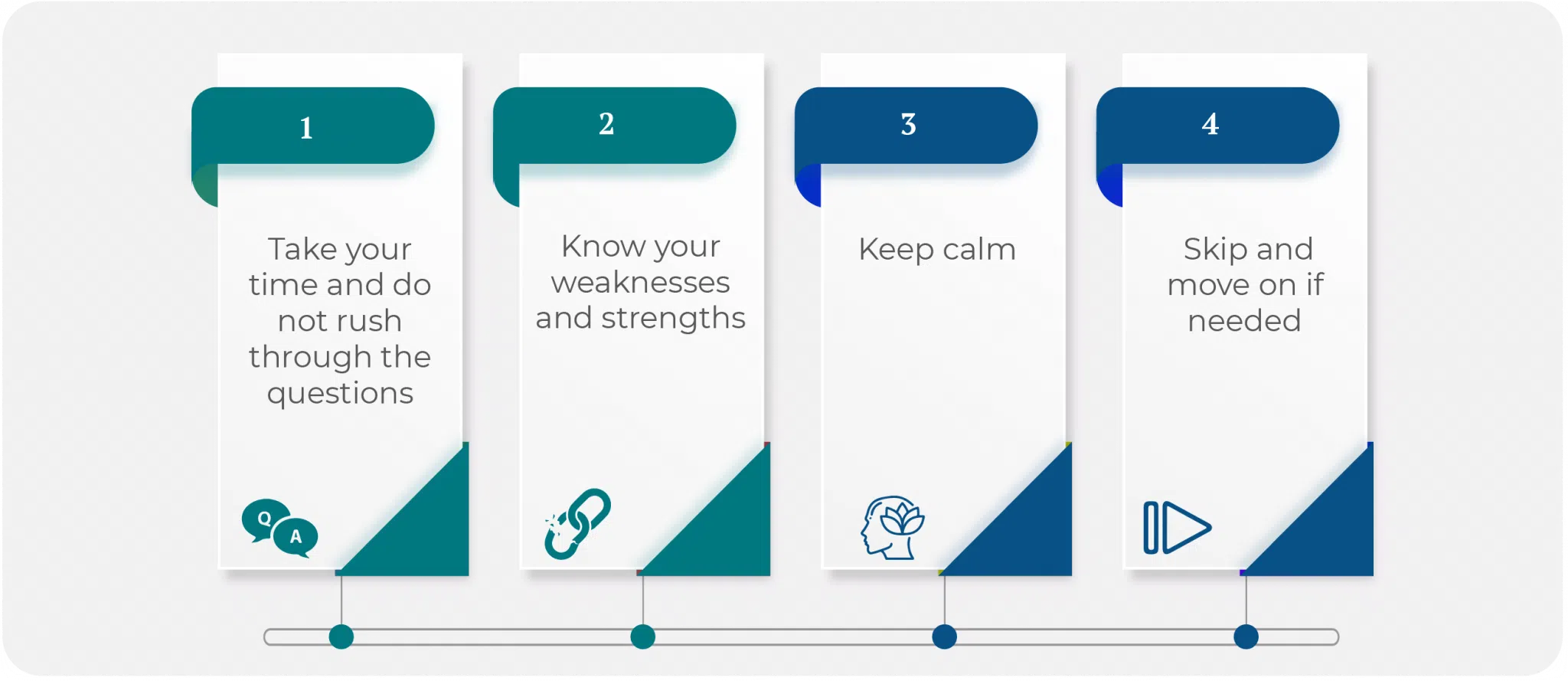
Administration
- Test Location: Most Florida students take the PERT test in 11th grade with their high school. Older students take the test at a university testing center.
- Test Schedule: Most students take the PERT test before registering for freshman classes.
- Test Format: Multiple choice, administered on a computer.
- Test Materials: Computer. Calculators are not permitted. However, the test has a pop-up calculator for some questions.
- Cost: Test is free for high school students. Different universities charge different fees, ranging from free to around $20.
- Retake Policy: Every school sets its own policy. However, most universities require some waiting period and completion of a prep course before retaking the PERT test.
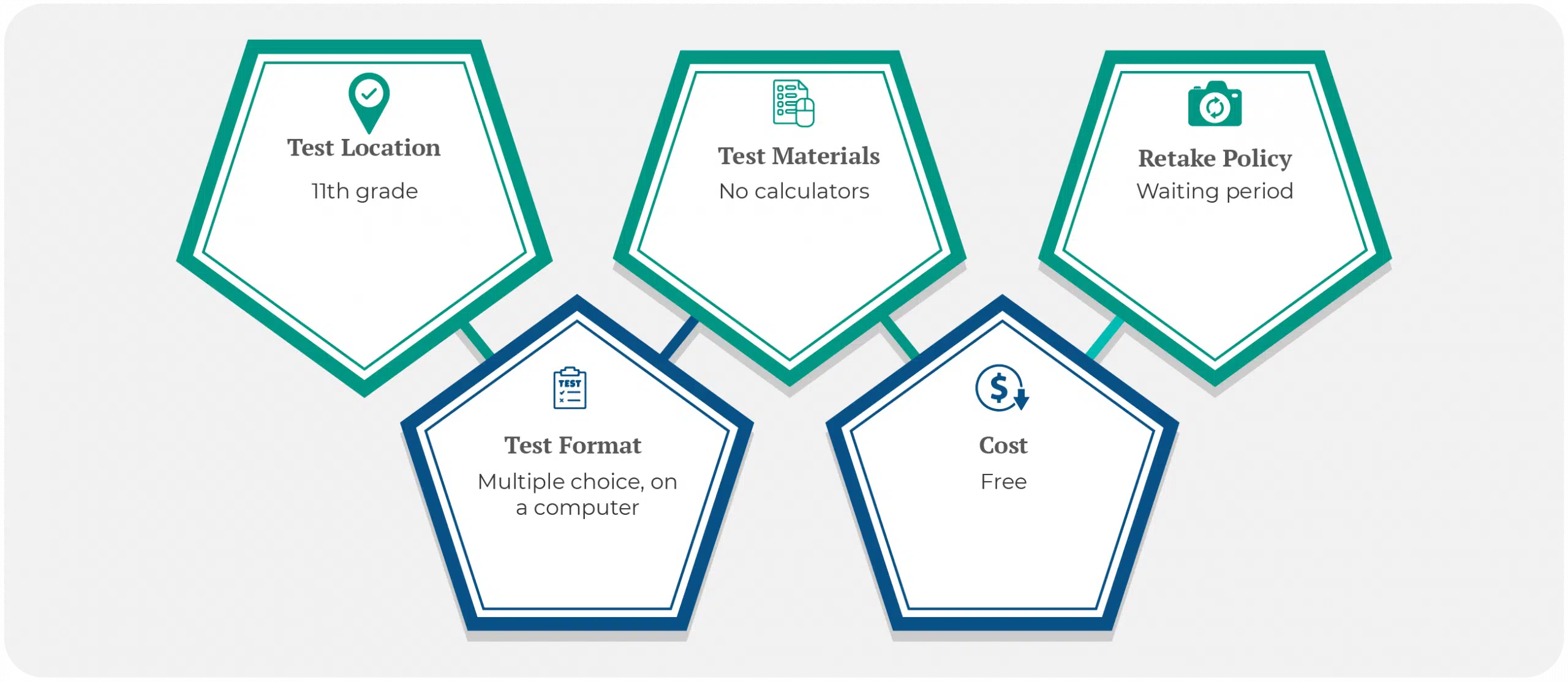
Test Provider
The Postsecondary Education Readiness Test was created by McCann and Associates, in conjunction with Florida educators. McCann has been creating assessment tests since 1959. The company is known for producing tests used by states, individual schools, and professional associations.
Information Sources
Disclaimer – All the information and prep materials on iPrep are genuine and were created for tutoring purposes. iPrep is not affiliated with McCann Associates, which is the publisher of the PERT test.
Free PERT practice test: Get to know what the Postsecondary Education Readiness Test (PERT) will be like by practicing with these sample questions:
Question 1 of 6
Simplify the following expression to its simplest form.
Consider B = 5 and C = -1:
(A3 + A)/A + (C + B)(B – C) – A2
- 25
- A3 – A2 + 24
- 2A2 – 23
- A + 24
The correct answer is 25.
Here’s a detailed video walk-through of the explanation:
In order to solve this question correctly, you need to remember the order of operations (PEMDAS):
- Parentheses
- Exponents
- Multiplication/Division
- Addition/Subtraction
| (A3 + A)/A + (C + B)(B – C) – A2 | Place values B = 5; C = -1 |
| (A3 + A)/A + (-1 + 5)(5 – (-1)) – A2 | Minus negative value is a positive addition |
| (A3 + A)/A + (-1 + 5)(5 + 1) – A2 | Addition within parentheses to resolve them |
| (A3 + A)/A + 4*6 – A2 | Since it is not directly connected to the left parentheses, the multiplication can be completed without distorting the result. |
| (A3 + A)/A + 24 – A2 | The distributive property allows applying divisor A to each of the elements within the parentheses which are separated by a plus/minus sign. This resolves the parentheses. |
| A3 /A + A/A + 24 – A2 | Reduce both expressions by A |
| A2 + 1/1 + 24 – A2 | A2 and – A2 cancel one another |
| 1 + 24 = 25 |
Tip: Look at the choices. The highest power in each of them is different. If you are 100% sure about the highest power, you can mark your choice even without fully solving the problem.
Question 2 of 6
Factor the polynomial
3x2 + 8x − 3
- (3x + 9)(x − 1)
- 3(x + 3)(x − 1)
- (3x – 2)(x + 4)
- (3x − 1)(x + 3)
The correct answer is (3x − 1)(x + 3).
Here’s a detailed video walk-through of the explanation:
The polynomial is 3x2 + 8x − 3
We try to separate the middle term +8x to find common factors with 3x2 and −3 separately:
3x2 + 9x − x − 3
Here, we see that 3x is a common factor for 3x2 and 9x, and -1 is a common factor for -x and
-3:
3x(x + 3) − 1(x + 3) = 0
Here, we have 3x times (x + 3) and −1 times (x + 3) summed up. This means that we have (3x − 1) times (x + 3):
(3x − 1)(x + 3)
Remember –
As an alternative solution path, you can always use the FOIL method and multiply each of the factors suggested in the answers. One of them ought to yield the correct polynomial.
In this particular case, this could even be a simpler way to find a solution.
Question 3 of 6
A 250-liter water tank is currently 36% full. How much more water is required to make it 50% full?
- 20 Liters
- 35 Liters
- 50 Liters
- 90 Liters
- 125 Liters
The correct answer is B.
Explanation:
The total capacity of the water tank = 250 liters
Given that 36% of the tank is full, the water missing that would make it 50% = 50% – 36% = 14%
14% of 250 Liters = 14% x 250 = (10% x 250) + (4% x 250) = (10/100 x 250) + (4/100 x 250) = 25 + 4 x 2.5 = 25 + 10 = 35 Liters
Solving Tip:
This question can be solved by a method of estimation, the remaining percentage of water needed to make it 50% full is 14%. Now, 12.5% is close to 14% and 12.5% of a value means that the value is divided by 8. So 12.5% of 250 liters = 250 / 8 = 31.2 liters which is closest to option ‘B’ the correct option.
Question 4 of 6
Which word is most different in meaning than the other words?
- flammable
- insidious
- combustible
- ignitable
- inflammable
The correct answer is insidious, meaning proceeding in a gradual, subtle way, but with harmful effects.
All the other words mean that something can be burned. Although there is the prefix “in-” before the word flammable, this does not mean that the item cannot light on fire suddenly. However, due to this confusion, it is more common to state that something is flammable. Inflammable means can ignite without an external fire source like a match. Insidious may resemble in sound “incendiary,” which also means flammable.
Question 5 of 6
Select the word that is spelled correctly.
- omited
- omitted
- ommitted
- ommited
The correct answer is omitted.
Only one “m” in omitted, however, there is a double “t”, which softens the “i.”
Question 6 of 6
Over the past 20 years, worldwide illiteracy rates have consistently declined. The main reason for this decline is the sharp increase in the literacy rates of young women, which is the result of campaigns to increase educational opportunities for girls. For example, between 1970 and 1990, the literacy rate among women in the United Arab Emirates increased from 7% to 76%.
According to the passage, which of the following is directly responsible for the sharp increase in literacy rates for young women?
- the United Arab Emirates
- increased funding for education
- a drop in illiteracy rates worldwide
- campaigns to increase educational opportunities for girls
The correct answer is D.
The information can be drawn from this section in the passage:
“The main reason for this decline is the sharp increase in the literacy rates of young women, which is the result of campaigns to increase educational opportunities for girls.“
Well done!
You have completed the Sample Questions section.
The complete iPREP course includes full test simulations with detailed explanations and study guides.
‘…TESTS THAT ACTUALLY HELP’

In the first 30 minutes of use I have learned so much more than skipping along the internet looking for free content. Don’t waste you time, pay and get tests that actually help.
Richard Rodgers
January 28, 2020 at 7:49 PM
